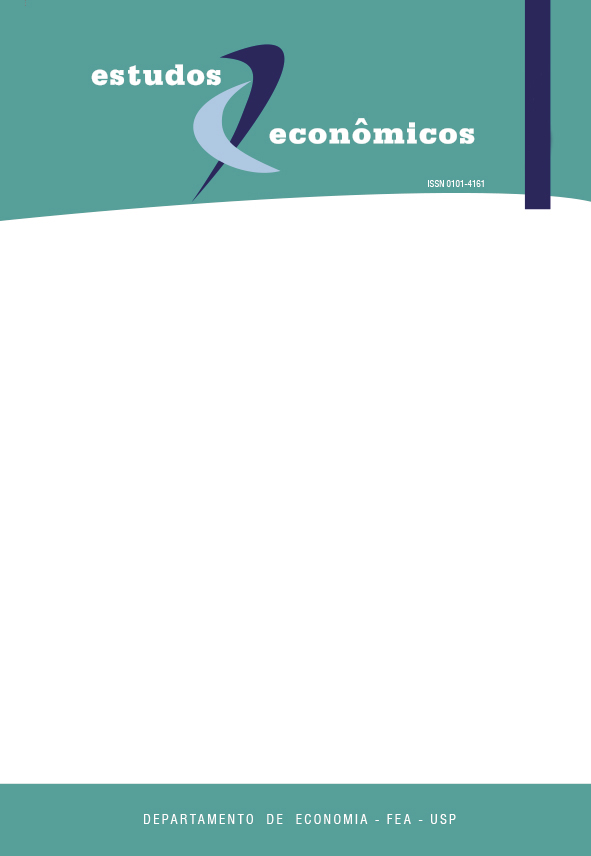A paridade do poder de compra: existe um quebra-cabeça?
DOI:
https://doi.org/10.1590/S0101-41612009000300001Keywords:
purchasing power parity, real exchange rate, long-run equilibrium real exchange rateAbstract
This paper shows that the purchasing power parity puzzle is a statistical artifact produced by the fact that the long run equilibrium real exchange rate is not constant, but changes throughout time. This fact implies that the inertia coefficient has an upward bias.Downloads
References
Balassa , Bela. The purchasing-power parity doctrine: a reappraisal. Journal of
Political Economy, 72, p. 584-596, 1964.
Cassel, Gustav. Abnormal deviations in international exchanges. Economic Journal,
, p. 413-415, 1918.
Dickey, David A.; Fuller, Wayne A. Likelihood ratio statistics for autoregressive
time series with a unit root. Econometrica, 49, p. 1057-1072, 1981.
Dornbusch, Rudiger. Expectations and exchange rate dynamics. Journal of Political
Economy, 84, p. 1161-1176, 1976.
Edwards , Sebastian. Real exchange rates, devaluation and adjustment. Cambridge:
Ma.: MIT Press, 1989.
Fleming, J. Marcus. Domestic financial policies under fixed and under floating
exchange rates. IMF Staff Papers 9, p. 369-379, 1962.
Harrod, Roy. International economics. Cambridge: Cambridge University Press, 1939.
Hinkle, Lawrence E.; Montiel, Peter J. Exchange rate misalignment concepts and measurement for developing countries. Oxford: Oxford University Press, 1999.
Michael, Panos; Nobay, A. Robert; Peel, David A. Transactions costs and nonlinear adjustment in real exchange rates: an empirical investigation. Journal of Political Economy, 105, p. 862-879, 1997.
Montiel, Peter. Determinants of the long-run equilibrium real exchange rate: an analytical model. In: Hinkle, Lawrence E.; Montiel, Peter J. (Org.), Exchange rate misalignment, concepts and measurement for developing countries. Oxford: Oxford University Press, 1999.
Mundell, Robert A. Capital mobility and stabilization policy under fixed and
flexible exchange rates. Canadian Journal of Economics and Political Science, 29,
p. 475-485, 1963.
Obstfeld, Maurice; Rogoff, Kenneth. Exchange rate dynamics redux. Journal of Political Economy, 103, p. 624-660, 1995.
Obstfeld, Maurice; Rogoff, Kenneth. Foundations of international economics. Cambridge: MA: MIT Press, 1996.
Rogoff, Kenneth. The purchasing power parity puzzle. Journal of Economic Literature, 34, p. 647-668, 1996.
Salter, Walter E. Internal and external balance: the role of price and expenditure effects. Economic Record, 35, p.226-238 1959.
Samuelson, Paul A. Theoretical notes on trade problems. Review of Economics and Statistics, 46, p. 145-154, 1964.
Swan , Trevor W. Economic control in a dependent economy. Economic Record, 36, p. 51-66, 1960.
Taylor, Mark P.; Peel, David A.; Sarno, Lucio. Nonlinear mean-reversion in real exchange rates: toward a solution to the purchasing power parity puzzles. International Economic Review, 42, p. 1015-1042, 2001.
Williamson, John. Estimating equilibrium exchange rates. Washington, D.C.: Institute for International Economics, 1974.
Downloads
Published
Issue
Section
License
Copyright (c) 2009 Fernando de Holanda Barbosa

This work is licensed under a Creative Commons Attribution-NonCommercial 4.0 International License.
By submitting an article, the author authorizes its publication and attests that it has not been submitted to any other journal. The original article is considered final. Articles selected for publication are proofread for grammatical and orthographic errors. The journal does not pay rights for published articles. The Institute of Economic Research from the School of Economics, Business and Accounting of the University of São Paulo (Instituto de Pesquisas Econômicas da Faculdade de Economia, Administração e Contabilidade da Universidade de São Paulo) owns the journal's copyright.





 Atualizado em 14/08/2025
Atualizado em 14/08/2025